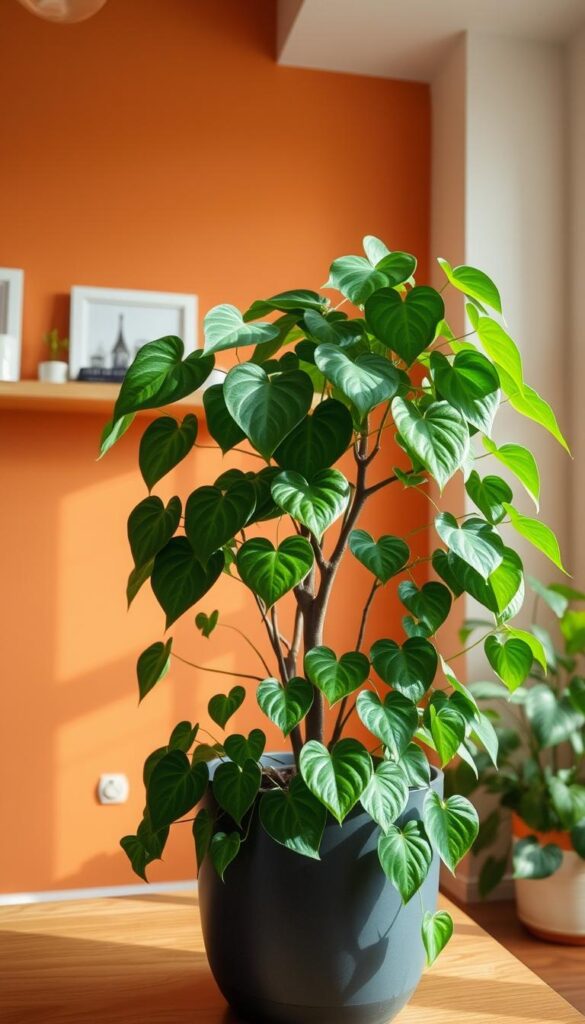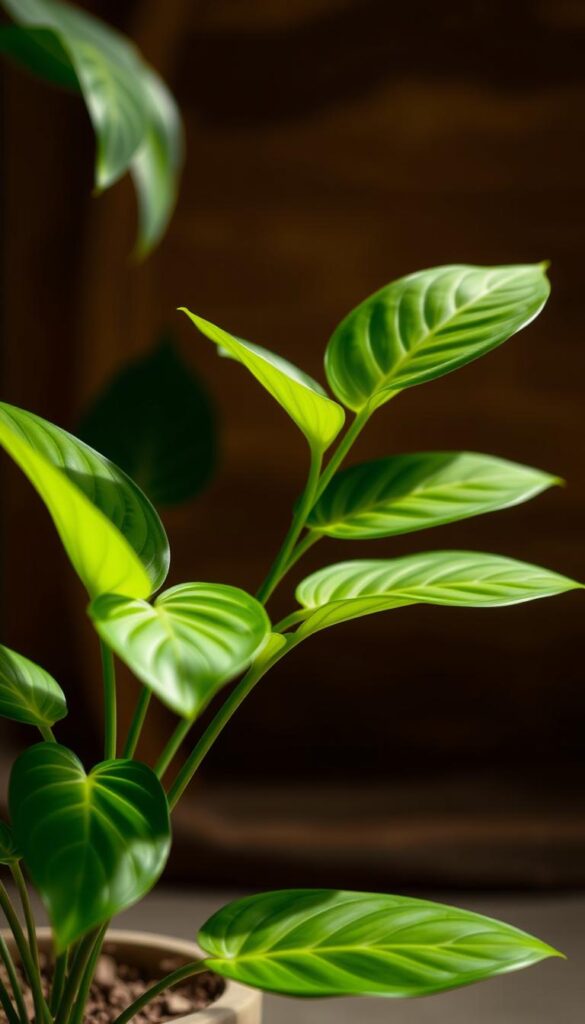Welcome to your ultimate guide on caring for the Philodendron Serpens, a true gem in the world of houseplants. This plant, with its striking hairy stems and lush, heart-shaped leaves, has captured the hearts of many plant enthusiasts. Whether you’re a seasoned plant parent or just starting your journey, this guide is here to help you master the art of nurturing your Philodendron Serpens.
What makes this plant so special? Its unique appearance, with those eye-catching fuzzy stems and vibrant green foliage, adds a touch of natural beauty to any room. Plus, it’s relatively low-maintenance, making it a great choice for busy individuals or those new to plant care.
In this guide, we’ll cover everything you need to know to keep your Philodendron Serpens thriving. From creating the ideal environment to understanding its watering, light, and humidity needs during the growing season, we’ve got you covered. Our expert tips are designed to be easy to follow, ensuring your plant stays healthy and flourishes under your care.
So, let’s dive in and explore how to give your Philodendron Serpens the best possible start in life. With the right care, this plant will bring joy and freshness to your home for years to come.
Getting to Know Philodendron Serpens
Let’s dive into the fascinating world of Philodendron Serpens, a plant that captivates with its unique beauty and adaptability. Native to the lush tropical rainforests of Central and South America, this plant has evolved to thrive in environments rich with moisture and dense foliage.
Origins and Natural Habitat
In its natural habitat, Philodendron Serpens grows as an epiphyte, using its climbing stems to ascend tree trunks and other structures. This adaptation allows it to reach for sunlight filtering through the dense rainforest canopy. The plant’s ability to cling to surfaces with its aerial roots highlights its resourceful nature.
Distinctive Features and Characteristics
What truly sets Philodendron Serpens apart is its striking appearance. The plant boasts deep green, heart-shaped leaves with a textured surface, giving them a unique, almost velvety feel. Its stems are notably fuzzy, a feature that not only adds to its charm but also aids in its climbing ability. These characteristics make it a standout choice for plant enthusiasts looking to add some tropical flair to their spaces.
Understanding the origins and features of Philodendron Serpens is key to providing the right care. By replicating its natural habitat, such as using support structures like trellises or moss poles, you can help your plant thrive indoors. This attention to detail ensures your Philodendron Serpens remains healthy and continues to captivate with its unique beauty.
philodendron serpens care guide: Essential Steps for a Thriving Plant
Creating the perfect environment for your plant is the first step toward ensuring it thrives. Since Philodendron Serpens is native to tropical rainforests, it loves high humidity and well-draining soil. Let’s break down how to set this up at home.
Setting Up the Ideal Environment
- Soil Mix: Use a mix of potting soil, perlite, and orchid bark. This blend ensures good drainage and aeration, preventing water from pooling in the soil.
- Moisture Balance: Keep the soil moist but not soggy. Overwatering can lead to root rot, so always check the soil before watering.
- Watering Tip: Water thoroughly, then let the top inch of soil dry out between waterings. This mimics the plant’s natural habitat.
- Environmental Conditions: Place your plant in a spot with bright, indirect light and maintain a humid environment, ideally between 50-70% humidity.

By following these steps, you can create a thriving environment for your plant. Remember, consistency is key to helping it flourish.
Optimizing Light, Water, and Soil Conditions
Creating the perfect environment for your plant involves balancing light, water, and soil. Let’s explore how to optimize these elements for healthy growth.
Finding the Perfect Lighting
Bright, indirect light is ideal. Direct sunlight can cause leaf scorch, so use sheer curtains or east/west-facing windows. For low-light areas, grow lights mimic natural conditions effectively.
Watering Strategies to Prevent Root Rot
Water thoroughly, allowing the top inch of soil to dry between sessions. Overwatering risks root rot. Check moisture by inserting a finger into the soil up to the knuckle.
Choosing and Mixing the Right Potting Soil
Use a mix of potting soil, perlite, and orchid bark for drainage and aeration. This prevents waterlogging and root rot. Repot annually in spring with fresh mix for best results.
By optimizing light, water, and soil, you create a thriving environment. Monitor and adjust these elements to keep your plant healthy and vibrant.
Maintaining Ideal Humidity and Temperature
Humidity and temperature play a crucial role in creating a thriving environment for your plant. Let’s explore how to maintain these conditions for optimal growth.
Boosting Humidity Levels in Your Home
Your plant loves high humidity, typically between 50-70%. To achieve this:
- Use a humidifier for consistent moisture levels.
- Mist the leaves with distilled water 2-3 times a week.
- Place the plant on a pebble tray filled with water to increase surrounding humidity.

Managing Indoor Temperature for Tropical Growth
Keep your plant in an area with a consistent temperature between 65°F and 80°F. Sudden changes can stress the plant, so avoid placing it near drafts or extreme cold spots. During seasonal changes, monitor indoor air quality to maintain stability and promote healthy growth.
Fertilizing and Preventing Pests
Fertilizing and preventing pests are crucial steps in keeping your plant healthy and thriving. Proper feeding ensures robust growth, while pest control maintains the plant’s integrity. Let’s explore the best practices for both.
Feeding Your Philodendron for Maximum Growth
A balanced fertilizer is essential during the growing season. Use a water-soluble fertilizer at half the recommended strength to avoid burning the roots. Feed your plant every 4-6 weeks for optimal results.
Avoid over-fertilizing, as it can lead to salt buildup in the soil. Always water your plant thoroughly before applying fertilizer to prevent root burn.
Natural Pest Control and Routine Maintenance
Common pests like spider mites and mealybugs can be managed naturally. Use neem oil or insecticidal soap, and isolate infected plants to prevent spread.
- Mist leaves regularly to deter pests and maintain humidity.
- Check for spider mites by inspecting the underside of leaves for fine webbing.
- Use a soft brush to gently remove mealybugs from the plant’s surface.
Regular maintenance is key. Inspect your plant weekly for signs of pests, and address issues promptly to prevent infestations. Remember, a healthy plant is a happy plant!
Designing Your Indoor Garden with Philodendron Serpens
Transform your living space into a lush oasis by incorporating the Philodendron Serpens into your indoor garden. This versatile plant offers endless possibilities for creative display, making it a perfect addition to any room.
Creative Display Ideas for Every Space
One of the joys of owning a Philodendron Serpens is its adaptability to various spaces. Whether you have a cozy apartment or a spacious home, there’s a way to showcase its beauty. Consider using hanging baskets or shelf displays to add a touch of greenery to your rooms. For smaller spaces, a compact pot on a side table or shelf works wonderfully, while larger areas can accommodate more elaborate arrangements.
Using Support Structures Like Trellises and Moss Poles
To enhance the natural climbing habit of your Philodendron Serpens, incorporate support structures like trellises or moss poles. These not only provide a framework for the plant to grow upward but also add a decorative element to your space. When choosing a pot, opt for one that complements the plant’s foliage while ensuring proper drainage and aeration for healthy growth.
By thoughtfully arranging your Philodendron Serpens with the right supports and in a well-chosen pot, you create an environment where the plant can thrive. This harmonious setup not only highlights the plant’s unique foliage but also elevates your home’s aesthetic, making it a true focal point of your indoor garden.
Propagation Techniques for New Growth
Propagating your plant is an exciting way to share it with friends or expand your collection. This process not only allows you to enjoy more of your favorite plant but also helps in preserving its unique characteristics. Let’s explore how to propagate your plant using stem cuttings, a method that ensures healthy growth and strong root development.
Stem Cutting Methods Explained
When selecting stem cuttings, look for healthy sections with multiple nodes—the small, joint-like areas on the stem. These nodes are where roots and new growth tend to develop most successfully. Using clean, sharp tools, cut just below a node to ensure the best chance of successful propagation.
Place the cuttings in a glass of water, making sure at least one node is fully submerged. Change the water every week to prevent bacterial growth, which can harm the developing roots. Keep the cuttings in bright, indirect light and wait for roots to form, usually within 2-3 weeks.
Transplanting Your New Cuttings with Care
Once roots have developed, it’s time to transplant the cuttings into soil. Gently place the rooted cutting into well-draining soil, taking care not to damage the delicate new roots. Water thoroughly after transplanting and continue to provide bright, indirect light for optimal growth.
Patience is key during this period. With proper care, your new plant will establish itself and begin to thrive. Remember, propagation is a process that requires attention and time, but the rewards are well worth the effort.
Final Reflections on Growing Your Indoor Jungle
Growing Philodendron Serpens is a rewarding journey that brings life and beauty to any indoor space. As you nurture your plant, remember that every detail—from the texture of its leaves to the balance of water in its soil—plays a role in its success. Regular monitoring of your plant’s leaves and roots helps catch issues early, ensuring healthy growth and vibrant foliage.
To avoid common pitfalls like rot, use a well-draining soil mix and avoid overwatering. Providing the right support, such as a moss pole, encourages strong growth. Maintaining proper light and humidity levels will keep your plant thriving, while consistent care prevents pests and ensures a robust root system.
Embrace the fulfilling challenge of caring for your indoor jungle. With passion and informed confidence, you’ll enjoy the many rewards of nurturing this beautiful plant. Happy growing!
